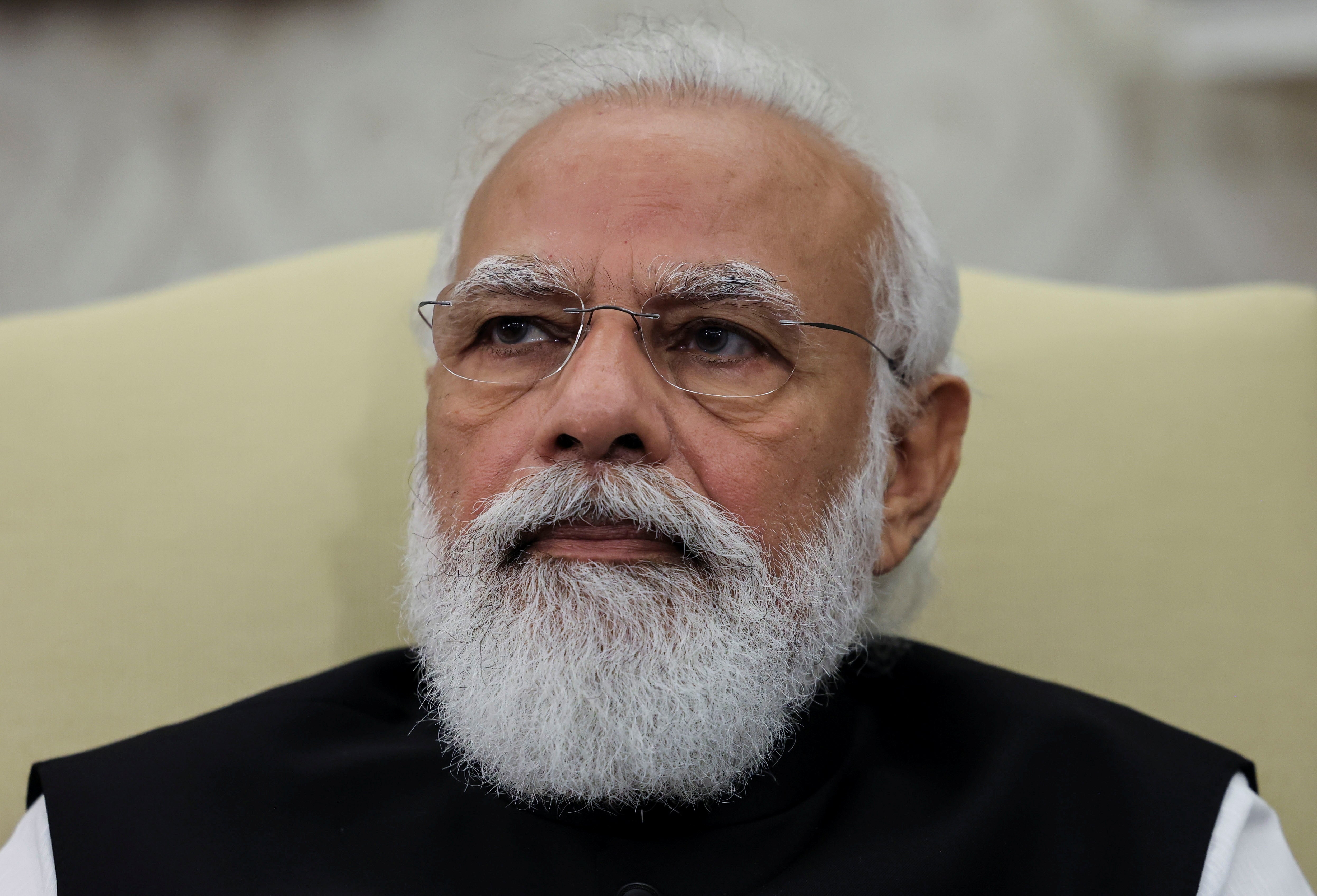Cop26: Will Modi announce strong climate action targets as India rejects net zero?
India is approaching Cop26 to hold developed countries responsible just as others will pressurise India to become net zero, reports Stuti Mishra


As Cop26 begins, several countries have announced net zero emissions targets, even the ones it was least expected from. However, one of the world’s largest polluters, India, has stayed away from such a commitment.
The climate negotiations in Glasgow will see a heavy push for countries to set a carbon neutrality target and there has already been tremendous pressure on India, the third-largest polluter, to declare one for itself.
Carbon neutrality or net zero refers to a state where a country is absorbing as much carbon as it emits. One of the most ambitious goals of the landmark Paris Agreement was that the world should cut emissions in half by 2030 and achieve global carbon neutrality by 2050, for a 50 per cent chance of limiting global heating to 1.5C.
The target got scientific backing with the latest IPCC report released on 9 August stating attaining net zero for greenhouse gas emissions is a requirement to stabilise human-induced global temperature at any level.
More than 130 countries have committed to carbon neutrality, as tracked by the Energy and Climate Intelligence Unit. Four of the world’s top five emitters of greenhouse gases – India being the exception – have announced targets for 2050 or beyond when their net emission contribution of carbon in the atmosphere is going to be zero.
Even Saudi Arabia, a global hub for oil production, has committed itself to a net zero target of 2060, stunning many.
Instead, India aims to reduce emissions intensity – or the amount of pollution relative to GDP – by 33 per cent by 2030, relative to 2005 levels, as part of its voluntary nationally determined contributions (NDCs).
While emissions intensity targets do not guarantee reductions in absolute emissions, India has made it clear that it doesn’t see net zero as a solution either.
Despite mounting international pressure, India’s environment secretary RP Gupta told reporters this week, instead of carbon neutrality, “It is how much carbon you are going to put in the atmosphere before reaching net zero that is more important.”
India’s federal environment minister Bhupendra Yadav also said India wants developed nations to take responsibility for their “historic” emissions, instead of pushing developing nations towards net zero targets.
Another major contention at the Cop26 will be a long-pending matter of climate finance – the $100bn promised by developed countries that most haven’t fulfilled yet.
India’s climate action targets up for review
While net zero remains at bay, India has committed itself to a set of legally binding climate action targets at the Paris Agreement, many of which the country is going to easily achieve in the coming years.
These include:
- Reducing the emissions intensity of its GDP by 33 per cent to 35 per cent by 2030 from the 2005 level
- Building an installed renewable capacity of 40 per cent
- Creating an additional carbon sink of 2.5 to 3 billion tonnes of CO2 equivalent through additional forest and tree cover by 2030
India’s top environment ministry officials say the country is well on track to meet its commitments.
Time and again, though, climate experts have demanded more stringent measures from India to curb its emissions. The Climate Action Tracker consortium, which tracks government climate actions, policies and targets, rated India’s commitments as “highly insufficient”.
“India should be making far more ambitious targets,” says Shweta Narayan, global climate and health campaigner at Health Care Without Harm. “It all sounds very good on paper, but the result on the ground is not in line with it and it means we need to do more.”
India has some of the most polluted cities in the world and yearly smog cover engulfs its northern areas in November. While prime minister Narendra Modi will be addressing the world about the country’s achievement towards green technology in Glasgow, India is once again expected to see worsening air quality levels with northern farmers burning stubble.
One field where India has done well in building future capacity is renewable energy. According to the latest government figures, India has already created an installed renewable capacity of 39 per cent, which makes its second NDC pledge almost fulfilled nine years earlier than scheduled. The installed capacity, however, only refers to the total capacity of the plants and with renewables like solar and wind, the output remains erratic and storage technologies become a key issue.
India could still possibly tick the target off its NDCs and replace it with a more ambitious target soon, but the ministry officials said any changes will be announced “at the right place and right time”.
Last month, when Modi addressed the UN General Assembly, he said India was on track to achieve 450 gigawatts of renewable energy target by 2030. Recently, the Indian renewable energy ministry said India produces 175GW of energy from renewable and if it makes it to the country’s new NDCs, that would essentially mean tripling the country’s present renewable capacity in less than a decade.
Despite the progress, India’s dependence remains largely on coal for its electricity generation. So much so, that a potential shortage earlier this month triggered blackouts and posed a threat to its businesses.
“What I find unfortunate in the Indian policy space is that while we are talking about advancing our renewable targets, we are still dependent on fossil fuel and we are expanding on fossil fuel,” Ms Narayan says. “That doesn’t make sense.”
India is one of the top three countries that is building more coal power plants. However, environment ministry official Mr Gupta, while addressing reporters on Wednesday, pointed out that “while we are building more coal plants, we are also retiring the old ones”.
If India continues to burn coal for electricity generation, the emissions will hardly go down and the reduction of fossil fuels is one of the biggest concerns to be discussed at Cop26.
Climate justice for climate action
India is expected to be among the world’s biggest contributors to emissions growth in coming years because of its fast-growing economy and increasing energy needs; it is expected to take over from China as the world’s most populous country by 2027, although its total emissions today are less than half of the US level.
The US reduced its dependence on coal because of its natural gas supply. Europe has also largely moved away from fossil fuel and according to International Energy Agency, its dependence is less than 50 per cent.
That isn’t the case yet for India and it has a large population to fulfil energy demands as it is still trying to provide electricity to more households. Naturally, the biggest concern India has in committing to net zero is how it would hamper its growth and poverty alleviation efforts.
But according to Aarti Khosla, director of Climate Trends, India “will not be able to stay out” of the list of countries that have net zero commitments for long.
“Whether we announce net zero by 2050 or by 2060, the direction of travel is set and that we will not be able to move away from,” she says. “It then remains a mere question of the announcement, whether we will announce net zero at this Cop, or we will do it at a later date.”
“The opportunities we will seize by committing ourselves to the renewable capacity of 450GW by 2030 or solid targets of electric mobility by 2030-2035, all of those demonstrate actions that we will anyway be taking towards net zero,” Ms Khosla adds.
While there’s no denying that reining in climate change requires tougher measures from all countries in the world and the Indian minister reiterated that India wants “to be a part of the solution”, India does want to hold developed countries responsible for their larger share of emissions, buying time for its own development.
India’s share of historical carbon footprints is minuscule compared to what the US and China have. Currently, India’s emissions rank third in the global list, accounting for 2.46 billion metric tonnes of carbon or 6.8 per cent of the total global emissions. India’s per capita carbon emissions are, however, still low at 1.84 tonnes compared to the United States’ 16.21 tonnes.
India has time and again said it is the victim of climate change and not a contributor, and the environment minister reiterated that India will “climate justice” from the upcoming negotiations.
“The issue really is that on finance, either what gets cobbled up is symbolic, or it is inadequate, or it has shifted the goal post, in either of these situations, it makes a case of where you should have trust,” Ms Khosla further says, “and when that happens I think the primary, fundamental pillar of living up to what was said before does not happen. And that is why [climate] finance has rightly become such a big issue.”
The concerns of growth and financing the green technology aren’t just only for India but shared by many other developing countries.
In 2009, developed countries had pledged to deliver to developing countries an annual climate fund of $100bn by 2020. The money is meant to fund climate adaptation and mitigation measures, yet very few countries have fulfilled that promise.
“Given on the one hand we talk about extraordinary action on climate, but when it comes to delivering on finance, then those countries that were primarily responsible delivering the finance are not able to give that amount,” she says, “and that creates a lot of distrust and inability of action overall.”
India’s environment minister Bhupender Yadav has stressed that India will emphasise climate justice and ask wealthier nations to transfer the technology and finance needed to help developing countries deal with the fallout from global warming at Cop26.
If Cop26 can manage to solve this conflict perhaps a more viable outcome can be expected from the summit. However, climate activists in the country say despite international posturing, the country needs to do more “to protect its own citizens”.
“India has a responsibility to protect our citizens and in order to do that, it would have to take very stringent measures, including emissions reductions, whether you call it net zero or you call it something else,” Ms Narayan says.
“The way things are changing on this planet is so uncertain, I would rather want something that’s more achievable and something that protects us in the next 10-15 years,” she adds. “For me, 2050 is big ahead in future, and that does not instil any confidence in me.”






Join our commenting forum
Join thought-provoking conversations, follow other Independent readers and see their replies
Comments